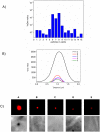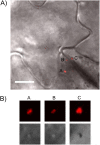Direct fluorescence detection of VirE2 secretion by Agrobacterium tumefaciens
- PMID: 28403156
- PMCID: PMC5389803
- DOI: 10.1371/journal.pone.0175273
Direct fluorescence detection of VirE2 secretion by Agrobacterium tumefaciens
Abstract
VirE2 is a ssDNA binding protein essential for virulence in Agrobacterium tumefaciens. A tetracysteine mutant (VirE2-TC) was prepared for in vitro and in vivo fluorescence imaging based on the ReAsH reagent. VirE2-TC was found to be biochemically active as it binds both ssDNA and the acidic secretion chaperone VirE1. It was also biologically functional in complementing virE2 null strains transforming Arabidopsis thaliana roots and Nicotiana tabacum leaves. In vitro experiments demonstrated a two-color fluorescent complex using VirE2-TC/ReAsH and Alexa Fluor 488 labeled ssDNA. In vivo, fluorescent VirE2-TC/ReAsH was detected in bacteria and in plant cells at time frames relevant to transformation.
Conflict of interest statement
Figures










Similar articles
-
Recognition of the Agrobacterium tumefaciens VirE2 translocation signal by the VirB/D4 transport system does not require VirE1.Plant Physiol. 2003 Nov;133(3):978-88. doi: 10.1104/pp.103.029223. Epub 2003 Oct 9. Plant Physiol. 2003. PMID: 14551327 Free PMC article.
-
The Agrobacterium tumefaciens chaperone-like protein, VirE1, interacts with VirE2 at domains required for single-stranded DNA binding and cooperative interaction.J Bacteriol. 1999 Nov;181(21):6850-5. doi: 10.1128/JB.181.21.6850-6855.1999. J Bacteriol. 1999. PMID: 10542192 Free PMC article.
-
Functional domains of Agrobacterium tumefaciens single-stranded DNA-binding protein VirE2.J Bacteriol. 1997 Feb;179(4):1165-73. doi: 10.1128/jb.179.4.1165-1173.1997. J Bacteriol. 1997. PMID: 9023198 Free PMC article.
-
Agrobacterium tumefaciens and A. rhizogenes use different proteins to transport bacterial DNA into the plant cell nucleus.Microb Biotechnol. 2009 Jul;2(4):416-27. doi: 10.1111/j.1751-7915.2009.00104.x. Epub 2009 Apr 6. Microb Biotechnol. 2009. PMID: 21255274 Free PMC article. Review.
-
The VirE2 protein of Agrobacterium tumefaciens: the Yin and Yang of T-DNA transfer.FEMS Microbiol Lett. 2003 Jun 6;223(1):1-6. doi: 10.1016/S0378-1097(03)00246-5. FEMS Microbiol Lett. 2003. PMID: 12798992 Review.
Cited by
-
Experimental Approaches to Visualize Effector Protein Translocation During Host-Pathogen Interactions.Bioessays. 2025 Apr;47(4):e202400188. doi: 10.1002/bies.202400188. Epub 2025 Mar 13. Bioessays. 2025. PMID: 40078034 Free PMC article. Review.
References
-
- Chilton MD, Drummond MH, Merio DJ, Sciaky D, Montoya AL, Gordon MP, et al. Stable incorporation of plasmid DNA into higher plant cells: the molecular basis of crown gall tumorigenesis. Cell. 1977;11: 263–271. - PubMed
MeSH terms
Substances
Grants and funding
LinkOut - more resources
Full Text Sources
Other Literature Sources

